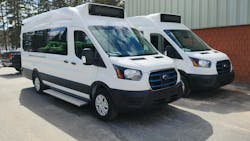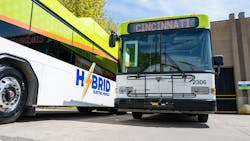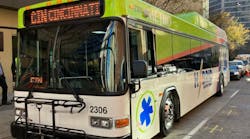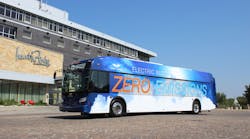BATA, Cincinnati Metro, SMRT receive new lower and zero-emission vehicles
The Bay Area Transportation Authority (BATA) in Michigan, Cincinnati Metro and Santa Maria Regional Transit (SMRT) in California have unveiled new lower and zero-emission vehicles for their respective agencies.
BATA
BATA has received four Ford Transit all-electric vans and expects delivery of two more electric vans equipped with mobility lifts later this year. The vehicles were purchased using state and federal transit vehicle grant funding. The agency notes the vans are still getting outfitted for service but when road-ready, they’ll initially be used for BATA’s on-demand Link service, providing emission-free door to door transportation for shopping, doctors’ appointments and employment.
Features of the new electric vans include:
- Seating for up to 10 passengers, with ADA accessible versions being able to accommodate up two wheelchairs each.
- Up to 130-mile range on a single charge.
- Smooth and quiet ride.
- Regenerative braking system.
- Onboard telematics to track battery life in real-time.
“We’re excited to expand BATA’s green fleet with the addition of these new electric vans,” said Kelly Dunham, BATA executive director. “Public transit is one of many environmentally friendly transportation options in our community and we’re pleased to make that option even greener with these new EVs.”
Electric vehicle (EV) chargers are planned for installation at BATA’s new operations headquarters opening this summer on the corner of Hammond and LaFranier Roads in Garfield Township, Mich. Fast EV chargers will also eventually be installed at BATA’s Hall Street Transfer Station.
Some of BATA’s other green initiatives include:
- Propane power: Around 60 percent of BATA’s bus fleet is propane powered, which emits lower greenhouse gas emissions, is a local fuel source and provides lower maintenance and operating costs.
- LEED certified: BATA’s Hall Street Transfer Station was one of the first LEED certified buildings in downtown Traverse City, which repurposed an existing Brownfield site, incorporated energy efficient lighting and HVAC systems and used locally sourced low emitting volatile organic compound building materials.
- Conservation: Twenty acres of the 50-acre parcel secured for BATA’s new operations center are being set aside for permanent preservation of wooded wetland protecting the headwaters of Mitchell Creek.
- Solar power: More than 15 bus stops throughout BATA’s network have lighting elements that are powered by the sun.
- Environmental benefits: Public transit makes a positive impact on the environment and the climate by helping reduce pollution, create healthier communities and reducing the number of cars on the road.
Cincinnati Metro
Cincinnati Metro has placed 10 new hybrid-electric buses into service. The fleet enhancements are at the forefront of Cincinnati Metro's sustainability efforts, which reflect a continued strategy towards greener, more efficient transit operations.
In the past decade, Cincinnati Metro has made significant investments in modernizing its fleet to include hybrid and mini-hybrid buses. The current fleet of 304 buses is all hybrid or mini-hybrid vehicles. In 2015, the fleet was comprised of 103 mini-hybrid buses, which represents a 295 percent increase in hybrid vehicles in that time frame.
Cincinnati Metro is also testing new technology on the hybrid-electric buses aimed at eliminating emissions in targeted zones where air quality concerns are heightened. Once within these geotargeted areas, the buses transition to full-electric mode, removing fuel use and resulting in zero-emissions.
"Advances in vehicle technology play a huge part in our sustainability efforts but it goes beyond just updating the fleet," said Darryl Haley, Cincinnati Metro’s CEO and general manager. "We have implemented a comprehensive range of initiatives aimed at minimizing our environmental footprint across all aspects of our operations."
Cincinnati Metro continues to recognize the importance of community engagement and collaboration in advancing its sustainability goals. Partnerships with many organizations across the Cincinnati region have been instrumental in advocating for and advancing environmentally sustainable initiatives. The agency says the collaborative efforts have helped secure millions of dollars in grants dedicated to enhancing sustainable transportation options in the Cincinnati, Ohio, region.
SMRT
SMRT received four New Flyer Xcelsior 35-foot electric buses. SMRT says the new electric transit vehicles are loaded with advanced, rider-centric features aimed at enhancing the overall commuting experience, including spacious interiors, health-promoting features, personal device charging capabilities and artificial intelligence technology.
"We are excited to introduce our new electric fleet and showcase our ongoing commitment to being a smart city and safe city," said SMRT Transit Services Manager Gamaliel Anguiano.
The four electric buses are in addition to the two SMRT currently has in service, bringing the total up to six, with 10 more electric buses expected to arrive later this year.

Brandon Lewis | Associate Editor
Brandon Lewis is a recent graduate of Kent State University with a bachelor’s degree in journalism. Lewis is a former freelance editorial assistant at Vehicle Service Pros in Endeavor Business Media’s Vehicle Repair Group. Lewis brings his knowledge of web managing, copyediting and SEO practices to Mass Transit Magazine as an associate editor. He is also a co-host of the Infrastructure Technology Podcast.








